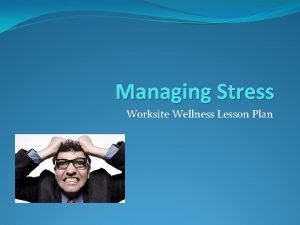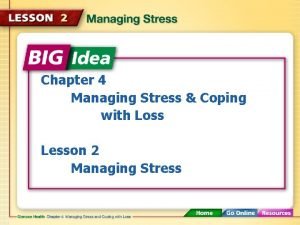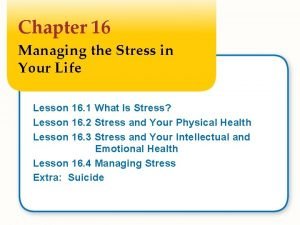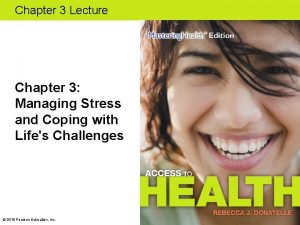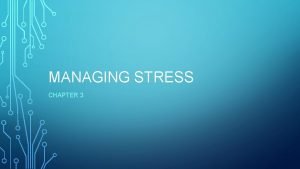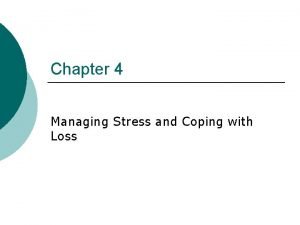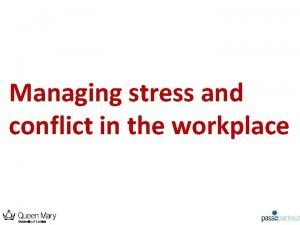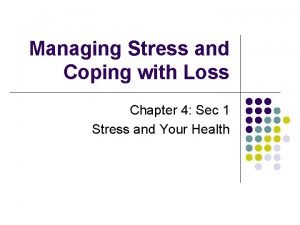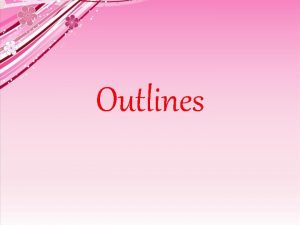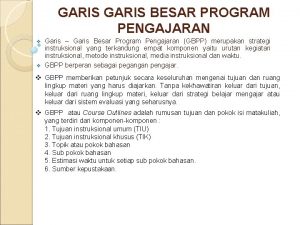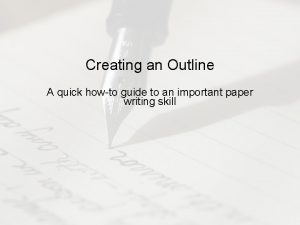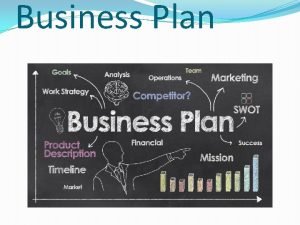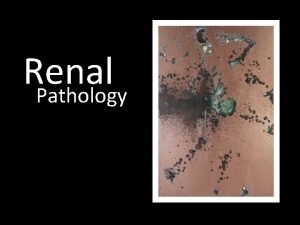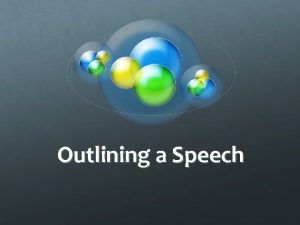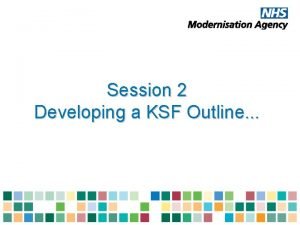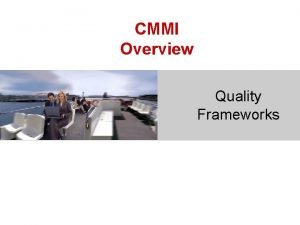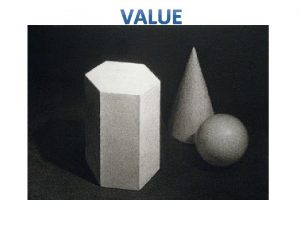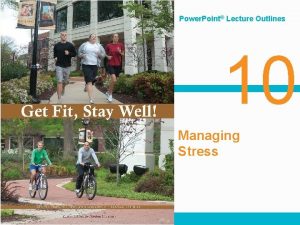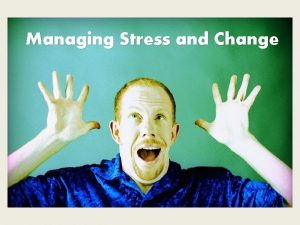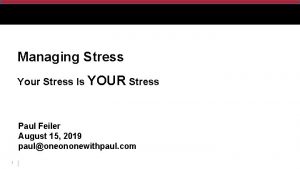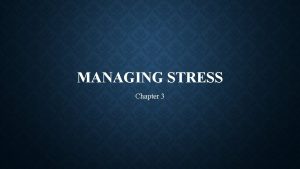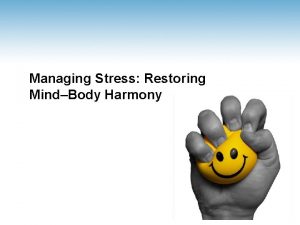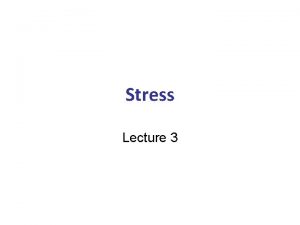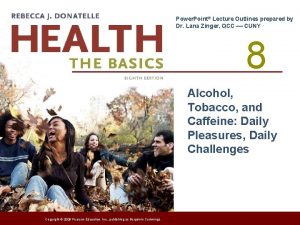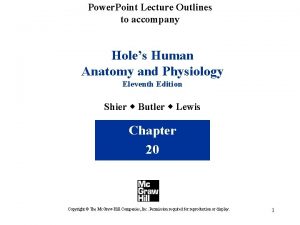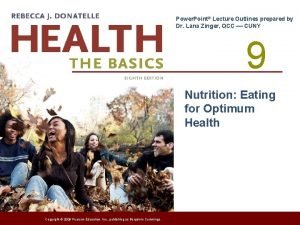Power Point Lecture Outlines 10 Managing Stress Copyright




































- Slides: 36

Power. Point® Lecture Outlines 10 Managing Stress Copyright © 2009 Pearson Education, Inc.

Objectives • Understand how your body responds to stress. • Identify common sources of stress. • Describe effective tools for stress management. • Create your own stress management plan. Copyright © 2009 Pearson Education, Inc.

Introduction • • • Stress has been linked to 70 -80 percent of all disease and illness 67% of adults say they experience great stress at least once per week Stress can be associated with positive or negative experiences Copyright © 2009 Pearson Education, Inc.

What Is Stress? Stress A physical, social, or psychological event that disrupts the body’s normal state and that the body tries to adapt to. Stressor Any event or circumstance that the body tries to adapt to; may be threatening, unfamiliar, disturbing, or exciting. Stress Response A set of reactions (physical and emotional) that your body initiates in response to a stressor. Eustress: Positive stress (can be motivating) Distress: Negative stress (can reduce wellness) Copyright © 2009 Pearson Education, Inc.

Sources of Stress • The first step in managing stress is to recognize the causes and to be aware of the symptoms. Copyright © 2009 Pearson Education, Inc.

Stressors • • Major - create emotional turmoil or require tremendous amounts of adjustment. • Personal Crises • Job/School-related pressures • Major age-related transitions Minor - shorter-term or less severe • Traffic hassles, peer/work relations, time pressures, family squabbles Copyright © 2009 Pearson Education, Inc.

Types of Stressors • • • Environmental Physiological Emotional*(psycho-social) Copyright © 2009 Pearson Education, Inc.

Major Sources of Stress Psychosocial, including from: • Change • Hassles • Performance demands • Inconsistent goals and behaviors • Conflict • Overload and burnout • Environmental sources Copyright © 2009 Pearson Education, Inc.

Major Sources of Stress Racial, ethnic, or cultural isolation can affect stress levels. Internal sources, including: • Low self-esteem (sense of positive self-regard). • Low self-efficacy (confidence in personal skills). Copyright © 2009 Pearson Education, Inc.

Stress-Prone Personalities • • Type A • Time-urgency • Competitive • Anger and hostility Type D – “Distressed” • Negative emotion (anxiety & depression) • “Social Inhibition, ” or the tendency not to express negative emotions in social interactions. Most people are not just one personality type. Contrast with psychological hardiness Copyright © 2009 Pearson Education, Inc.

Personality Type & Stress Type A Increased risk of heart disease (anger, cynicism, hostility) l React more explosively to stressors l Copyright © 2009 Pearson Education, Inc. Type B l Kobasa found “hardy” people coped more positively with stress & found fewer stressful situations

Other factors: l Family background l Cultural background l Gender roles l Past experiences Copyright © 2009 Pearson Education, Inc.

Characteristics of Stressful Events • Negative • Uncontrollable • Ambiguous Copyright © 2009 Pearson Education, Inc.

Reactions to Stress • • All people have a general reaction to stress. Fight-or-Flight response • Men more prone to hostility • Women – tend & befriend Copyright © 2009 Pearson Education, Inc.

The Stress Response Steps: • The senses and brain perceive a threat. • The brain sends a signal, releasing several hormones into your bloodstream. • More hormones are released by your adrenal glands. • These “stress hormones” trigger the conversion of stored fat, protein, and carbohydrates into glucose for energy to respond. • The physiological result is the “fight or flight” syndrome: the body reaches a heightened state of stress-related readiness to either flee from or confront a threat. • Fight or flight response/Tend or befriend model. Copyright © 2009 Pearson Education, Inc.

The Stress Response Copyright © 2009 Pearson Education, Inc.

The General Adaptation Syndrome (GAS) A model of stress reaction based on the idea of homeostasis: a state of physiological equilibrium. Stages of the general adaptation syndrome: • Alarm • Resistance • Exhaustion Hans Seyle’s work is credited with recognizing that sustained stress takes a toll on wellness. Copyright © 2009 Pearson Education, Inc.

The General Adaptation Syndrome Copyright © 2009 Pearson Education, Inc.

Other Ways Stress Causes Harm Allostasis • The many changes that occur in the body in order to maintain homeostasis. Allostatic Load • Long-term wear and tear on the body caused by prolonged/chronic stress. • Allostatic load can result from either too many or too few stress hormones released into your system as a result of sustained stress and stressors. Copyright © 2009 Pearson Education, Inc.

Kinds of Harm Stress Can Cause • Cardiovascular disease – heart rate + & risks greater for hypertension, heart attack, and stroke. • Immune system function impairment. Too much stress over a long period can negatively regulate cellular immune responses. • Mental disability, including depression, anxiety, and post-traumatic stress disorder (PTSD). Copyright © 2009 Pearson Education, Inc.

Health problems linked to stress l l l Cardiovascular problems Cancer Colds Chronic infections Asthma Allergies Copyright © 2009 Pearson Education, Inc. l l l Digestive problems Headaches Insomnia Fatigue Injuries Pregnancy complications

ABC News: Stress Management | Stress Management Discussion Questions: • In what situations have school, friends, family, or work caused you to eat when you were not hungry? • How is “cortisol-induced stress fat” different from storage of fat caused by non–stress-related eating? • What are the health risks for both types of fat accumulation? • How does the perception of hopelessness, helplessness, and defeat influence cortisol levels in the body? Copyright © 2009 Pearson Education, Inc.

Contemporary Views of the Nature of Stress The Process of Stress Appraisal Stressor Stress Coping Outcome The amount or intensity of stress is not the main factor affecting one’s health, it’s how a person manages, copes or deals with the stress the determines negative or positive impact. Copyright © 2009 Pearson Education, Inc.

Stress - Appraisal & Response High Stress Healthy See stressor as a threat Appraisal Stressor Stress Response See stressor as a challenge Low Stress Copyright © 2009 Pearson Education, Inc. Unhealthy

Hardiness • • • Commitment Control Challenge Individuals high in “Hardiness” have fewer stress related problems due to the way they perceive stress and the coping mechanisms they use (“approach” coping instead of “avoidance” coping) Copyright © 2009 Pearson Education, Inc.

Unhealthy Responses to Stress • What are some unhealthy responses to Stress? • Smoking • Overeating or poor nutrition • Alcohol/Drugs • Procrastination • Avoidance • Ignoring/Suppressing • Frustration Copyright © 2009 Pearson Education, Inc.

Effective Tools for Stress Management Exercise and get physical activity. Cultivate basic wellness measures: • Eat right, get enough sleep, avoid tobacco and alcohol. Change your behavioral responses: • Assess the stressor. • Change your response. • Look into cognitive coping strategies. • Prepare ahead of stressful events. • Calm down & breathe deeply Copyright © 2009 Pearson Education, Inc.

Techniques For Managing Stress • • Social Support Communication Physical activity Eat well Adequate Sleep Time management Spirituality Journal writing Copyright © 2009 Pearson Education, Inc.

Physical Activity • • • Helps you to adapt to stressful situations Provides a break from reality (“Time Out” hypothesis) Improves mood and self-esteem Reduces anxiety and depression Can aid in changing behaviors related to health Copyright © 2009 Pearson Education, Inc.

Relaxation Techniques • • • Progressive relaxation Visualization Meditation Deep breathing Hatha yoga Tai chi Music Biofeedback Hypnosis Copyright © 2009 Pearson Education, Inc.

Time Management • • Set priorities Work when you are most productive Set realistic goals Break tasks into parts Do the least favorite tasks first Delegate responsibilities Learn to say “NO” Take breaks and have some fun! Copyright © 2009 Pearson Education, Inc.

Cognitive Techniques • • Only worry about things you control Problem-solve for peace of mind Keep expectations reasonable Make self-talk positive Un-clutter you mind Forget the past and focus on the future Learn to laugh at yourself Learn to be flexible and forgiving Copyright © 2009 Pearson Education, Inc.

Social Support • • • Effective in stress management. May be particularly important for women. (Tend or Befriend Model) Variety of sources Obtaining social support requires close relationships Accountability & Prayer groups Quality, not quantity that counts Copyright © 2009 Pearson Education, Inc.

Preventing Negatives from Stress • • • Be physically active Get sufficient sleep Build a strong social support system Allow time for recreation Engage in effective time management Copyright © 2009 Pearson Education, Inc.

Effective Tools for Stress Management Manage your time, thoughts, and emotions: • Assess and prioritize how you spend your time. • Positive “self-talk” • Manage negative emotions and anger (Eph. 4: 26) Engage in meaningful spiritual practice: • Spirituality has been found in studies to correlate with a reduced perception of stress. • Prayer (Phil. 4: 6 -7) • Sharing your burden (Phil. 4: 14 & Gal. 6: 2) Copyright © 2009 Pearson Education, Inc.

Creating Your Own Stress-Management Plan Step One: Assess Yourself Use Lab 10. 1 to get started. Step Two: Plan for Change Select one stress-producing behavior pattern to focus on changing. Step Three: Chart Your Progress Use a journal to record progress, set-backs, data, and your thoughts on the process. Use it to make a plan and revise as needed. Copyright © 2009 Pearson Education, Inc.
 01:640:244 lecture notes - lecture 15: plat, idah, farad
01:640:244 lecture notes - lecture 15: plat, idah, farad Managing stress
Managing stress Chapter 8 managing stress and anxiety
Chapter 8 managing stress and anxiety Leasiest
Leasiest Chapter 4 lesson 2 managing stress answer key
Chapter 4 lesson 2 managing stress answer key Change and stress management
Change and stress management Chapter 16 managing the stress in your life
Chapter 16 managing the stress in your life Chapter 3 managing stress
Chapter 3 managing stress Chapter 3 managing stress
Chapter 3 managing stress Chapter 4 managing stress and coping with loss lesson 1
Chapter 4 managing stress and coping with loss lesson 1 Managing stress and conflict in the workplace
Managing stress and conflict in the workplace Managing stress and coping with loss
Managing stress and coping with loss Power triangle diagram
Power triangle diagram Powerbi in powerpoint
Powerbi in powerpoint True fracture strain
True fracture strain Axial normal stress
Axial normal stress Chapter 10 stress responses and stress management
Chapter 10 stress responses and stress management Point point power
Point point power Parallelism outline examples
Parallelism outline examples Tujuan garis besar adalah
Tujuan garis besar adalah Prison ministry training manual download
Prison ministry training manual download Commercial law outline
Commercial law outline Four main components for effective outlines
Four main components for effective outlines A business plan is a document that outlines
A business plan is a document that outlines Pyelonephritis
Pyelonephritis Sermon outlines on the shunammite woman
Sermon outlines on the shunammite woman Anime out line
Anime out line Two types of outlines
Two types of outlines A haunted house by virginia woolf analysis
A haunted house by virginia woolf analysis Ksf outlines
Ksf outlines Mucoepidermoid carcinoma histology
Mucoepidermoid carcinoma histology High level outline
High level outline The book of acts outline
The book of acts outline Exegetical outline example
Exegetical outline example Cjis security policy
Cjis security policy Mun position paper outline
Mun position paper outline Visible outlines
Visible outlines

